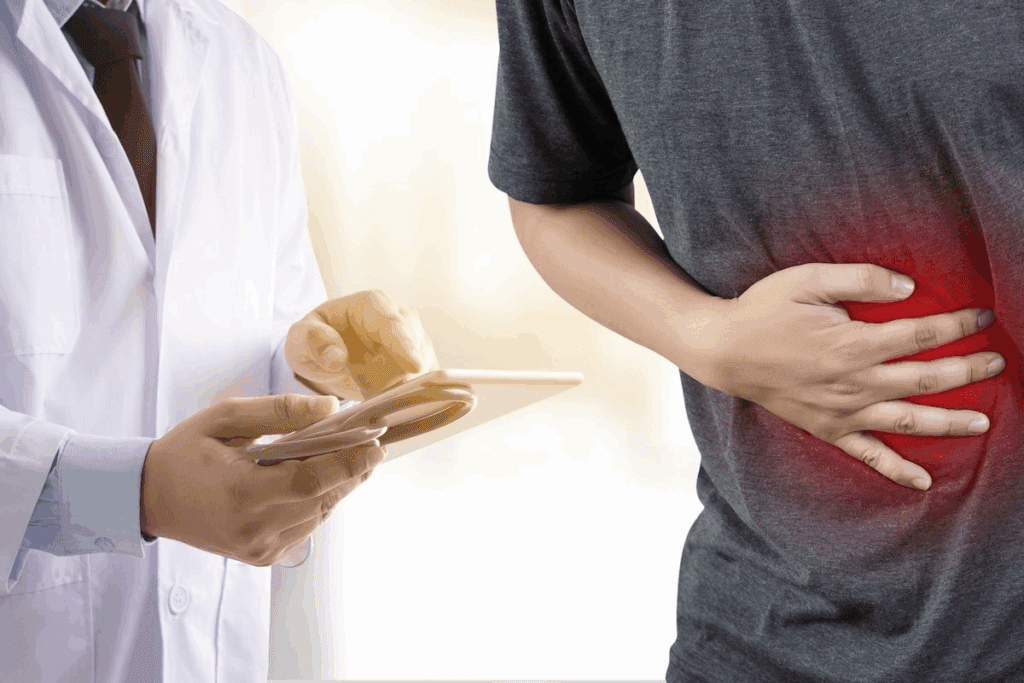Last Updated on November 26, 2025 by Bilal Hasdemir

A bowel obstruction happens when the intestine becomes blocked, stopping food, fluids, and gas from moving normally through the digestive tract.
This condition can cause serious complications if not treated quickly. Recognizing bowel obstruction symptoms early is vital for getting medical help and preventing further problems. Common bowel obstruction symptoms include abdominal pain, bloating, nausea, vomiting, and constipation.
There are two main types of bowel obstruction — complete and partial — each with its own causes and warning signs. Understanding the differences helps ensure the right treatment is given in time.

A bowel obstruction happens when the intestine gets blocked. This blockage can be in the small or large intestine. It can be partial or complete.
This blockage stops food, fluids, gas, and stool from moving through the digestive tract. It leads to symptoms and serious complications.
Bowel obstruction is when the intestine gets blocked. This blockage can be from scar tissue, hernias, tumors, or inflammatory bowel disease. It stops the intestine from moving food and waste properly.
The blockage can make the intestine swell. This can cut off blood supply and cause damage. Knowing how it works helps find the cause and how to treat it.
Bowel obstruction is common in some groups. It depends on the cause, like surgery or cancer. Risk factors include age, surgery history, and certain diseases.
Knowing these risk factors helps catch it early. Early signs in at-risk people can lead to quick treatment. This can prevent serious problems.

Bowel obstruction symptoms can vary a lot. But, there are key signs to watch for. Spotting these signs early is key for good treatment and avoiding problems.
Abdominal pain or cramping is a common symptom. The pain can be mild or very severe. It may stay the same or change.
This pain happens because the bowel tries to move stuff past the blockage.
Vomiting and nausea are also common symptoms. Vomiting can get worse if the blockage isn’t treated. This can lead to dehydration and imbalances in electrolytes.
Bloating and a swollen abdomen happen when the bowel fills with gas and fluid. This can be uncomfortable and may make the belly look bigger.
Not being able to pass gas is a big symptom. It shows the bowel’s normal movement is blocked. This leads to a buildup of gas and fluid.
It’s important to know the different types of bowel obstruction to get the right treatment. These obstructions fall into three main groups: mechanical, nonmechanical, and pseudo-obstructions.
Mechanical obstructions happen when something physically blocks the intestine. This can be because of adhesions from previous surgeries, hernias, or tumors. They can be either partial or complete, depending on how bad the blockage is.
Nonmechanical obstructions, or paralytic ileus, happen when the intestines’ muscles don’t work right. This stops food, fluids, and gases from moving through. It can be caused by postoperative complications, medication side effects, or underlying medical conditions.
Pseudo-obstructions look like true bowel obstructions but don’t have a physical blockage. They can be caused by neurological disorders or muscular diseases that mess with how the intestines move.
The table below shows the main differences between these types of bowel obstruction:
| Type of Obstruction | Causes | Characteristics |
| Mechanical Obstruction | Adhesions, hernias, tumors | Physical blockage, partial or complete |
| Nonmechanical Obstruction (Paralytic Ileus) | Postoperative complications, medication side effects, underlying conditions | No physical blockage, impaired intestinal motility |
| Pseudo-Obstruction | Neurological disorders, muscular diseases | No physical blockage, mimics obstruction symptoms |
It’s important to know the differences between small bowel and large bowel obstructions. Both can be serious, but they need different treatments. Their symptoms and causes are unique.
Small bowel obstructions happen more often. They start suddenly with pain, vomiting, and bloating. The small intestine is narrower, making it more likely to get blocked. Medical studies show that adhesions from past surgeries are a big reason for these obstructions.
Large bowel obstructions grow over time. They cause constipation, swelling, and vomiting of feces. The large intestine is less blocked, but when it is, cancer and diverticulitis are common reasons. Knowing the differences helps doctors choose the right treatment.
| Characteristics | Small Bowel Obstruction | Large Bowel Obstruction |
| Onset of Symptoms | Sudden | Gradual |
| Common Symptoms | Abdominal pain, vomiting, bloating | Constipation, abdominal distension, fecal vomiting |
| Common Causes | Adhesions, hernias | Colorectal cancer, diverticulitis |
It’s important to know the difference between partial and complete bowel obstruction. This is because bowel obstruction, where the intestines get blocked, can vary in how serious it is.
A partial bowel obstruction lets some fluids and gas move through. Symptoms include pain, bloating, and nausea. Doctors might watch it, change your diet, or even operate to fix it.
The signs of partial obstruction can be hard to spot. Early detection is key to stop it from getting worse.
| Characteristics | Partial Obstruction | Complete Obstruction |
| Symptom Severity | Intermittent, may be mild | Severe, sudden onset |
| Passage of Fluids/Gas | Some passage possible | No passage |
| Urgency for Treatment | Monitoring, possible surgery | Immediate medical emergency |
A complete bowel obstruction is a serious emergency. Nothing can pass through. Symptoms include severe pain, vomiting, and no bowel movements. Surgery is usually needed right away to fix it.
Prompt recognition and treatment of complete bowel obstruction are critical to prevent serious problems like bowel ischemia and perforation.
The intestines can get blocked by different mechanical factors. This makes it hard for things to move through. It’s a serious issue that needs quick medical help.
Adhesions from past surgeries often cause bowel obstructions. These adhesions can stick to the intestines. This blocks the normal flow of contents. A study on managing malignant bowel obstruction found adhesions are a big worry for those who’ve had surgery symptom guidelines.
Hernias are another common reason for bowel obstructions. If a hernia gets stuck or strangulated, it can block the intestine. This can lead to serious problems if not treated fast. Hernias can happen anywhere in the abdominal wall, and their complications can be severe.
Tumors and cancerous growths in the intestines can also block the bowel. As these tumors grow, they can narrow the intestine. This is a big problem for people with colorectal cancer.
Impacted stool and severe constipation can also cause obstructions. When stool becomes hard and stuck, it can block the intestine. This is common in older people or those with long-term constipation.
Nonmechanical bowel obstruction includes conditions like paralytic ileus. This is when the intestines don’t move properly without any blockage. It happens when things affect the muscles of the intestines.
Some medicines can slow down the intestines, causing nonmechanical bowel obstruction. Opioids are known to slow bowel movements, leading to paralytic ileus. Other drugs, like anticholinergics and some antidepressants, can also cause problems. They relax the intestinal muscles or mess with the nerves controlling bowel movements.
Neurological and muscular disorders can also cause nonmechanical bowel obstruction. Parkinson’s disease and multiple sclerosis can mess with the nerves controlling the intestines. This makes it hard for the intestines to move food through. Muscular dystrophy and other muscle diseases can also harm the intestinal muscles, causing pseudo-obstruction.
Knowing what causes nonmechanical bowel obstruction is key to treating it. It shows why a detailed medical check-up is so important.
It’s important to know what causes colon obstruction. This knowledge helps doctors diagnose and treat it better. Colon obstruction happens when something blocks the colon, causing serious symptoms.
Colorectal cancer is a big reason for colon obstruction. Tumors can grow big enough to block the colon. It’s key to find and treat colorectal cancer early to avoid blockages. Screening for colorectal cancer is important for those at risk.
Diverticulitis is when the colon gets inflamed. This can narrow the colon and cause blockages. Severe cases might need surgery.
Inflammatory bowel diseases (IBD) like Crohn’s and ulcerative colitis can harm the colon. They cause inflammation and scarring. It’s vital to manage IBD with medicine and lifestyle changes to avoid blockages.
Diagnosing bowel obstruction involves several steps. It includes clinical evaluation, imaging studies, and lab tests. Accurate diagnosis is key to the right treatment and avoiding complications.
A physical exam is the first step. Doctors look for bloating, tenderness, and swelling in the belly. They also listen for unusual sounds with a stethoscope. A detailed physical exam helps figure out how bad the blockage is and what tests to do next.
Imaging tests are vital for confirming bowel obstruction. CT scans, X-rays, and ultrasound
Labs check the patient’s overall health and look for complications. Blood tests check for imbalances, infections, or distress. Lab results help doctors create a treatment plan that fits the patient’s needs.
Knowing when to get help for bowel obstruction can save lives. This condition is serious and can cause severe problems if not treated quickly.
Some symptoms mean you need to go to the emergency room right away. Look out for severe, sudden abdominal pain, not being able to pass gas or stool, and signs of dehydration or shock. If you see these signs, get help fast.
When you go to see a doctor, tell them everything. Describe your symptoms well, including when they started and what makes them better or worse. Also, share any recent health issues, surgeries, medicines, or past bowel obstruction problems.
Bowel obstruction is a serious medical issue that needs quick action. Knowing bowel obstruction symptoms and signs of bowel obstruction is key for early detection and treatment.
The importance of early detection is huge. Quick medical help can greatly improve outcomes and avoid serious problems. If you or someone you know has persistent abdominal pain, vomiting, or trouble passing gas or having a bowel movement, get medical help right away.
By learning about bowel obstruction causes, types, and symptoms, you can help keep your gut healthy. Early treatment of bowel obstruction can greatly improve recovery and overall health.
Symptoms include abdominal pain and cramping, vomiting, and nausea. You might also feel bloated, have a swollen abdomen, and struggle to pass gas or stool.
It can be caused by mechanical issues like adhesions, hernias, or tumors. Or it might be due to nonmechanical reasons, such as medication side effects or muscle and nerve disorders.
Small bowel obstructions are more severe and sudden. They cause severe pain, vomiting, and dehydration. Large bowel obstructions are slower and may cause constipation, bloating, and a swollen abdomen.
Doctors use physical exams, imaging tests like CT scans, and lab tests. These help find the cause and severity of the obstruction.
Signs include severe pain, constant vomiting, and trouble passing gas or stool. A swollen abdomen is also a warning sign that needs immediate medical help.
Sometimes, partial obstructions can be treated without surgery. This might include rest, hydration, and medication. But, complete obstructions usually need surgery.
Untreated obstructions can lead to serious problems. These include bowel ischemia, perforation, peritonitis, sepsis, and even death if not treated quickly.
To prevent it, manage constipation and avoid heavy lifting to prevent hernias. If you’ve had abdominal surgery or have certain conditions, watch for signs of obstruction.
Tell your doctor about your symptoms, when they started, and any changes in bowel habits. Share details about your abdominal pain and any relevant medical history.
Yes, risk factors include previous abdominal surgery, hernias, Crohn’s disease, and being older.
Yes, some medications can cause or contribute to bowel obstruction. This is true for those that affect bowel movement, like opioids.
Pseudo-obstruction is a condition that feels like a true bowel obstruction but doesn’t have a physical blockage. It’s often due to muscle or nerve disorders in the intestines.
References
Khalil, H. M., et al. (2021). Biliary leakage following cholecystectomy: A prospective population study. Journal of Research in Medical and Dental Science, 9(5), 289-296. Retrieved from https://www.jrmds.in/articles/biliary-leakage-following-cholecystectomy-a-prospective-population-study-84919.html
Subscribe to our e-newsletter to stay informed about the latest innovations in the world of health and exclusive offers!